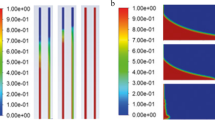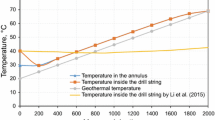In this paper the authors have put forward the concept of annular zero gas flow and developed the residual gas model, considering the parameters of gas solubility, slippage, and the oil-based drilling fluid volume coefficient [1-3]. The calculation results show that in the process of continuous gas influx at the bottom of the well, the phenomenon of annular zero gas flow can be defined in terms of gas solubility [4-6]. The increase in the back pressure, the decrease in the gas invasion rate, and the decrease in the oil-based ratio can cause an increase in the length of the annular zero gas flow well section. When the back pressure increases from 0.1 to 4.0 MPa, the length of the annular zero gas flow section increases from 1000 to 2700 m. If the zero gas flow is not taken into consideration, the maximum error of the annular void ratio is 21.22% [7-10]. When the CO2, gas invades the bottom of the well, the oil-based ratio increases from 0.1 to 5, the length of the annular zero gas flow section increases from 1500 to 2250 m, and the maximum error of the annular void ratio is 26.57%.




Similar content being viewed by others
References
W. Bacon, “Consideration of compressibility effects for applied-back pressure dynamic well control response to a gas kick in managed pressure drilling operations,” Master’s thesis, University of Texas, Arlington, USA (2011).
W. Guo, F. Honghai, and L. Gang, “Design and calculation of a MPD model with constant bottom hole pressure,” Pet. Explor Dev., 38(1), 103-108 (2011).
H. Santos et. al., “Micro-flux control: the next generation in drilling process for ultra deepwater,” 15062-OTC, Offshore Technology Conference, Houston, Texas, 5-8 May (2003).
C. Vogelpohl, C. Brandenbusch, and G. Sadowski, “High-pressure gas solubility in multicomponent solvent systems for hydroformylation. Part II: Syngas solubility,” J. Supercrit. Fluids, 88, 74-84 (2014).
A. Bahadori, H. B. Vuthaluru, and S. Mokhatab, “Analyzing solubility of acid gas and light alkenes in triethylene glycol,” J. Nat. Gas Chem., 01, 51-58 (2008).
F. Esmaeilzadeh, I. Goodarznia, and R. Danesh, “Solubility calculation of oil-contaminated drill cuttings in supercritical carbon dioxide using statistical associating fluid theory (PC-SAFT),” Chem. Eng. Tech., 31(1), 66-70 (2008).
J. J. Hidalgo, C. W. MacMinn, and R. Juanes, “Dynamics of convective dissolution from a migrating current of carbon dioxide,” Adv. Water Res., 62, 511-519 (2013).
E. Khamehchi, F. Rashidi, H. Rasouli, and A. Ebrahimian, “Novel empirical correlations for estimation of bubble point pressure, saturated viscosity, and gas solubility of crude oils,” Pet. Sci., 6, 86-90 (2009).
B. Yu, H. Cong, and X. Zhao, “Hybrid brominated sulfonated poly (2,6-diphenyl-l,4-phenylene oxide) and SiO2, nanocomposite membranes for CO2/N2 separation,” Prog. Nat. Set.: Mater. Int., 22(6), 661-667 (2012).
P. L. O’Bryan, A. T. Bourgoyne, T. G. Monger, et al., “An experimental study of gas solubility in oil-based drilling fluids,” SPE Drill. Eng., 3, 33-42 (1988).
Acknowledgment
The research has been funded by the Scientific Research and Technological Development of CNP? as part of the project “Integration and test of quick drilling and completion technology in key areas such as the south edge of Junggar and Mahu,” project No.2019F-33.
Author information
Authors and Affiliations
Corresponding author
Additional information
Translated from Khimiya i Tekhnologiya Topliv i Masel, No. 5, pp. 79 – 82, September – October, 2020.
Rights and permissions
About this article
Cite this article
Teng, W., Shi, J., Wu, B. et al. Influence of Gas Solubility on Zero Gas Flow Characteristics in MPD Operation. Chem Technol Fuels Oils 56, 830–835 (2020). https://doi.org/10.1007/s10553-020-01195-7
Published:
Issue Date:
DOI: https://doi.org/10.1007/s10553-020-01195-7




